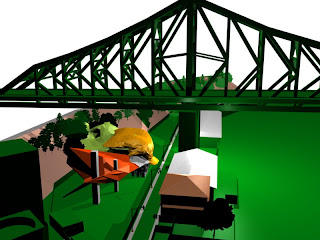Below are a series of experiments with different settings and views in an attempt to create a tsunami like wave through the structure and site.
The video above does not portray a wave very well. I need to zoom out to see more of the site. It is also very pixilated so I will need to change some render settings before I bake it again.
In this experiment, I have moved the camera so that more of the site is showing. However I have still kept the camera quite low in order to show a sectional analysis of the wave. This has still not worked as the camera is soon covered by the wave - which is hollow somehow.
Now I have moved the camera up even more, looking at the site from a birds eye view. This gives a perfect indication of the wave analysis. However I still need to change the render settings.
The render settings in the domain section of the fluid bake has now been set from 50 to 70. Surface Sub is 2 and Surface Smooth is 1.5 (as used from initial wave experiments during class). I like this video as the fluid tends to 'crawl' over the site! This gives another whole new oppourtunity to explore my design.















